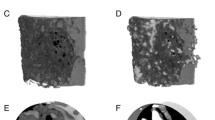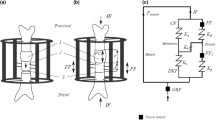Abstract
Bone formation in a variety of contexts depends on angiogenesis; however, there are few reports of the vascular response to osteogenic skeletal loading. We used the rat forelimb compression model to characterize vascular changes after fatigue loading. The right forelimbs of 72 adult rats were loaded cyclically in vivo to one of four displacement levels, to produce four discrete levels of ulnar damage. Rats were killed 3–14 days after loading, and their vasculature was perfused with silicone rubber. Transverse histological sections were cut along the ulnar diaphysis. We quantified vessel number, average vessel area, total vessel area, and bone area. On day 3, we observed a dramatic periosteal expansion near the ulnar midshaft, with significant increases in periosteal vascularity; total vessel area was increased 250–450% (P < 0.001). Vascularity remained elevated on days 7 and 14. Vessel number and average vessel area were not correlated (P = 0.09) and contributed independently to total vascular increases. Bone area was not increased on day 3 but on days 7 and 14 was increased significantly in all displacement groups (P < 0.01) due to periosteal woven bone formation. Vascular and bone changes depended on longitudinal location (P < 0.001), with peak increases 2 mm distal to the midshaft. Vascular and bone changes also depended on displacement level (P < 0.005), with greater increases at higher levels of fatigue displacement. We conclude that skeletal fatigue loading induces a rapid increase in periosteal vascularity, followed by an increase in bone area. The angiogenic-osteogenic response is spatially coordinated and scaled to the level of the mechanical stimulus.




Similar content being viewed by others
References
Brandi ML, Collin-Osdoby P (2006) Vascular biology and the skeleton. J Bone Miner Res 21:183–192
Pechak DG, Kujawa MJ, Caplan AI (1986) Morphological and histochemical events during first bone formation in embryonic chick limbs. Bone 7:441–458
Ferrara N (2001) Role of vascular endothelial growth factor in regulation of physiological angiogenesis. Am J Physiol Cell Physiol 280:C1358–C1366
Gerber HP, Vu TH, Ryan AM, Kowalski J, Werb Z, Ferrara N (1999) VEGF couples hypertrophic cartilage remodeling, ossification and angiogenesis during endochondral bone formation. Nat Med 5:623–628
Glowacki J (1998) Angiogenesis in fracture repair. Clin Orthop Relat Res 355S:S82–S89
Hausman MR, Schaffler MB, Majeska RJ (2001) Prevention of fracture healing in rats by an inhibitor of angiogenesis. Bone 29:560–564
Ilizarov GA (1990) Clinical application of the tension-stress effect for limb lengthening. Clin Orthop Relat Res:8–26
Jazrawi LM, Majeska RJ, Klein ML, Kagel E, Stromberg L, Einhorn TA (1998) Bone and cartilage formation in an experimental model of distraction osteogenesis. J Orthop Trauma 12:111–116
Li G, Simpson AH, Kenwright J, Triffitt JT (1999) Effect of lengthening rate on angiogenesis during distraction osteogenesis. J Orthop Res 17:362–367
Choi IH, Chung CY, Cho TJ, Yoo WJ (2002) Angiogenesis and mineralization during distraction osteogenesis. J Korean Med Sci 17:435–447
Fang TD, Salim A, Xia W, Nacamuli RP, Guccione S, Song HM, Carano RA, Filvaroff EH, Bednarski MD, Giaccia AJ, Longaker MT (2005) Angiogenesis is required for successful bone induction during distraction osteogenesis. J Bone Miner Res 20:1114–1124
Street J, Bao M, deGuzman L, Bunting S, Peale FV Jr, Ferrara N, Steinmetz H, Hoeffel J, Cleland JL, Daugherty A, van Bruggen N, Redmond HP, Carano RA, Filvaroff EH (2002) Vascular endothelial growth factor stimulates bone repair by promoting angiogenesis and bone turnover. Proc Natl Acad Sci USA 99:9656–9661
Forwood MR, Turner CH (1995) Skeletal adaptations to mechanical usage: results from tibial loading studies in rats. Bone 17:197S–205S
Rubin CT, Lanyon LE (1984) Regulation of bone formation by applied dynamic loads. J Bone Joint Surg Am 66:397–402
Barou O, Mekraldi L, Vico G., Boivin G, Alexandre C, Lafage-Proust MH (2002) Relationships between trabecular bone remodeling and bone vascularization: a quantitative study. Bone 30:604–612
Yao Z, Lafage-Proust MH, Plouet J, Bloomfield S, Alexandre C, Vico L (2004) Increase of both angiogenesis and bone mass in response to exercise depends on VEGF. J Bone Miner Res 19:1471–1480
Muir P, Sample SJ, Barrett JG, McCarthy J, Vanderby R Jr, Markel MD, Prokuski LJ, Kalscheur VL (2007) Effect of fatigue loading and associated matrix microdamage on bone blood flow and interstitial fluid flow. Bone 40:948–956
Torrance AG, Mosley JR, Suswillo RFL, Lanyon LE (1994) Noninvasive loading of the rat ulna in vivo induces a strain-related modeling response uncomplicated by trauma or periosteal pressure. Calcif Tissue Int 54:241–247
Hsieh YF, Silva MJ (2002) In vivo fatigue loading of the rat ulna induces both bone formation and resorption and leads to time-related changes in bone mechanical properties and density. J Orthop Res 20:764–771
Tami AE, Nasser P, Schaffler MB, Knothe Tate ML (2003) Noninvasive fatigue fracture model of the rat ulna. J Orthop Res 21:1018–1024
Li J, Miller MA, Hutchins GD, Burr DB (2005) Imaging bone microdamage in vivo with positron emission tomography. Bone 37:819–824
Silva MJ, Uthgenannt BA, Rutlin JR, Wohl GR, Lewis JS, Welch MJ (2006) In vivo skeletal imaging of 18F-fluoride with positron emission tomography reveals damage- and time-dependent responses to fatigue loading in the rat ulna. Bone 39:229–236
Blau M, Ganatra R, Bender MA (1972) 18 F-fluoride for bone imaging. Semin Nucl Med 2:31–37
Genant HK, Bautovich GJ, Singh M, Lathrop KA, Harper PV (1974) Bone-seeking radionuclides: an in vivo study of factors affecting skeletal uptake. Radiology 113:373–382
Mosley JR, March BM, Lynch J, Lanyon LE (1997) Strain magnitude related changes in whole bone architecture in growing rats. Bone 20:191–198
Hsieh YF, Wang T, Turner CH (1999) Viscoelastic response of the rat loading model: implications for studies of strain-adaptive bone formation. Bone 25:379–382
Kotha SP, Hsieh Y-F, Strigel RM, Muller R, Silva MJ (2004) Experimental and finite element analysis of the rat ulnar loading model – correlations between strain and bone formation following fatigue loading. J Biomech 37:541–548
Hsieh Y-F, Robling AG, Ambrosius WT, Burr DB, Turner CH (2001) Mechanical loading of diaphyseal bone in vivo: the strain threshold for an osteogenic response varies with location. J Bone Miner Res 16:2291–2297
Mosley JR, Lanyon LE (1998) Strain rate as a controlling influence on adaptive modeling in response to dynamic loading of the ulna in growing male rats. Bone 23:313–318
Danova NA, Colopy SA, Radtke CL, Kalscheur VL, Markel MD, Vanderby R, McCabe RP, Escarcega AJ, Muir P (2003) Degradation of bone structural properties by accumulation and coalescence of microcracks. Bone 33:197–205
Uthgenannt BA, Silva MJ (2007) Use of the rat forelimb compression model to create discrete levels of bone damage in vivo. J Biomech 40:317–324
Bentolila V, Boyce TM, Fyhrie DP, Drumb R, Skerry TM, Schaffler MB (1998) Intracortical remodeling in adult rat long bones after fatigue loading. Bone 23:275–281
Pacicca DM, Patel N, Lee C, Salisbury K, Lehmann W, Carvalho R, Gerstenfeld LC, Einhorn TA (2003) Expression of angiogenic factors during distraction osteogenesis. Bone 33:889–898
Aronson J, Harrison BH, Stewart CL, Harp JH Jr (1989) The histology of distraction osteogenesis using different external fixators. Clin Orthop Rel Res 241:106–116
Ilizarov GA (1989) The tension-stress effect on the genesis and growth of tissues: part II. The influence of the rate and frequency of distraction. Clin Orthop Rel Res 239:106–116
Aronson J, Shen XC, Skinner RA, Hogue WR, Badger TM, Lumpkin CK Jr (1997) Rat model of distraction osteogenesis. J Orthop Res 15:221–226
Yasui N, Sato M, Ochi T, Kimura T, Kawahata H, Kitamura Y, Nomura S (1997) Three modes of ossification during distraction osteogenesis in the rat. J Bone Joint Surg Br 79:824–830
Guldberg RE, Ballock RT, Boyan BD, Duvall CL, Lin AS, Nagaraja S, Oest M, Phillips J, Porter BD, Robertson G, Taylor WR (2003) Analyzing bone, blood vessels, and biomaterials with microcomputed tomography. IEEE Eng Med Biol Mag 22:77–83
Acknowledgement
The authors thank Pat Keller and Crystal Idleburg for histological sectioning and staining. Funding was provided by a grant from the U.S. National Institutes of Health/National Institute of Arthritis and Musculoskeletal and Skin Diseases (AR050211).
Author information
Authors and Affiliations
Corresponding author
Rights and permissions
About this article
Cite this article
Matsuzaki, H., Wohl, G.R., Novack, D.V. et al. Damaging Fatigue Loading Stimulates Increases in Periosteal Vascularity at Sites of Bone Formation in the Rat Ulna. Calcif Tissue Int 80, 391–399 (2007). https://doi.org/10.1007/s00223-007-9031-3
Received:
Revised:
Accepted:
Published:
Issue Date:
DOI: https://doi.org/10.1007/s00223-007-9031-3




